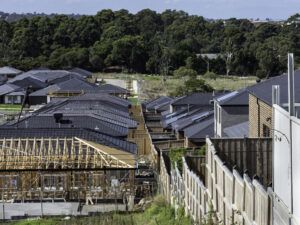
The Tasmanian Government proudly declares it’s on track to deliver 10,000 new affordable homes by 2032. Strip away the glossy headlines and what remains is a hollow boast built on creative accounting. The numbers simply don’t add up.
When examining Homes Tasmania’s performance as reported in the 2024/25 Annual Report, isn’t just disappointing performance against its corporate plan, but fundamental flaws in how success is being measured and reported to the public.
Homes Tasmania’s September 2025 dashboard claims 4,422 dwellings delivered or 44% of target. Sounds impressive. Until you dig deeper. The actual number of new homes added to Tasmania’s housing stock is 2,937 dwellings which is just 29% of target.
That’s 1,485 dwellings that are counted, reported and celebrated that don’t exist.
This is achieved through creative accounting and double counting.
Affordable rentals – Homes Tasmania reports 981 dwellings delivered. The reality? Most are existing private rentals under temporary two-year head leases through the Private Rental Incentives Scheme. When leases renew, they’re counted again. Same dwelling, multiple tallies, inflating the numbers.
Even worse, only 260 of these dwellings remain active in the program. The other 519 are gone and no longer providing affordable housing, yet still counted as permanent achievements toward the 10,000 target.
Affordable home purchases – of 1,063 homes reported, 652, 61 percent, are existing properties being purchased. Helping Tasmanians into homeownership is worthy, but buying existing homes adds zero dwellings to our housing stock. It’s shifting the deck chairs, not new supply.
Residential lots – until July 2025, Homes Tasmania counted vacant land as completed housing before a single foundation was poured. When the rules changed, numbers plummeted overnight from 411 to 109. Even now, there’s no tracking of whether these lots have been built on.
This isn’t progress. It denies the lived reality of many Tasmanians needing to be housed – what should be a fundamental human right.
The deception runs deeper. The 10,000 target was never based on Tasmania’s actual housing need. It was reverse-engineered to fit a $1.5 billion budget set by the government. Again, we see this government letting the wallet determine the goal rather than the goal determining the investment.
The Salvation Army’s Social Justice Stocktake 2025 is unequivocal. Tasmania has 1,338 people experiencing homelessness and an unmet housing need of 8,100 dwellings. Meeting this requires at least 500 new social housing dwellings annually through to 2041 and 5,000 over the program’s life.
The government’s target? Just 3,000 social housing dwellings. What could be considered a deliberate shortfall of 2,000 homes against assessed need.
Worse still, 56% of the overall target, including affordable rentals and home purchases, doesn’t necessarily add new supply at all. The program was shaped by budget constraints, not community needs. When I examined the budget papers, I found no analysis of whether $1.5 billion would suffice, no modelling of optimal portfolio mix, no consideration of housing types most needed.
This is not a housing strategy.
The financial structure reveals further concern. Homes Tasmania is accumulating debt projected to reach $1.014 billion by 2028-29, with $50 million in annual interest covered by Treasury.
Think about what $50 million annually could deliver instead. Community housing providers delivering actual new supply, crisis accommodation services desperately short of resources, homelessness prevention programs proven to work and maintenance of deteriorating social housing stock, to name a few.
Instead, we’re servicing debt on a program that isn’t delivering what it promises.
Then the even bigger question – how will this debt be repaid? Social housing doesn’t generate commercial returns. Most funding goes to community housing providers as grants. The only options are gutting future housing budgets or selling off the social housing portfolio. Either way, Tasmanians lose.
This lack of planning has real consequences. When the Housing Australia Future Fund offered Round 1 funding in 2024, Homes Tasmania struck out completely. Not one successful application.
Why? Presumably because we didn’t have shovel-ready, well-costed projects prepared and did not compare favourably with the other jurisdictions who did, thus Tasmania came away empty-handed.
That’s Commonwealth funding that could have delivered hundreds of homes, lost presumably because we hadn’t done the work to be competitive. Instead, we lurch from one ad-hoc project to another, generating community resistance, missing federal opportunities, and squandering chances to coordinate procurement and support local apprentices.
Tasmanians in housing stress need a safe place to live and they need solutions grounded in reality.
Counting the same temporary rental multiple times isn’t innovative. Purchasing existing homes and calling it new supply isn’t creative. Tallying vacant blocks as completed housing isn’t optimistic. Tasmanians need and deserve honesty and policy based on need.
We need honest metrics. New housing supply means newly constructed dwellings, purchase of newly built homes not previously occupied, renovation of uninhabitable properties, or conversion of non-residential buildings. These measures need to be delivered to meet identified need and not use accounting tricks to paint a better picture.
The housing crisis demands transparency, strategic planning, and honest accounting. This is what the government has failed to provide.
We need accurate numbers and an investment pipeline based on demonstrated need, with projects ready when Commonwealth funding opportunities arise. The government needs to admit when targets aren’t being met and look to redirect that $50 million annual interest bill to actual housing delivery.
The current approach would seem to serve one purpose – to make the government look good while Tasmanians sleep in cars and tents.
Tasmania has a genuine housing crisis. Pretending we’re solving it with phantom dwellings and creative counting only makes it worse. And every day we continue down this path it’s real people paying the price.

